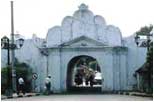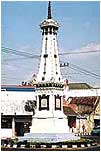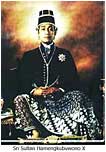|
It is located in
the center of the city of Yogyakarta or just Yogya as the local people
call it. Karaton means a place where the Ratu-king lives, other
word is Kedaton, with the same meaning. In the Javanese teachings,
it has a deep philosophical meaning.
The architect designer of this palace was Sultan
Hamengkubuwono I himself, who was also the founder of the kingdom of
NGAYOGYAKARTA HADININGRAT. His skill in architecture was
appreciated by the dutch scientist - DR. Pigeund and DR. Adam who adored
him as " the architect of his brother-Pakubuwono II of Surakarta".
The first king moved to his huge and magnificent Karaton on October 7,
1756. Although there are some European style of some parts of the
building, structurally this is the vivid example of Javanese palace
architecture. The 14.000 sq. m of the Karaton Yogya has deep philosophical meaning
with all its building, courts, carving, trees, and location. This is a
Karaton full of significant symbols of human life.
Usually visitors are coming from MALIOBORO STREET, southward
through the Alun-alun (north square). In order to understand perfectly
well the symbolic meaning of the Karaton, one should walk from south to
north. Start from Krapyak, a village of about 3 km south of Karaton.
SKETCH
|
1.
|
In the old days, Krapyak was
a raised brick-stage, used by the sultans to watch his families and
soldiers to hunting deers. Krapyak is located nearby small village,
Mijen - from the word wiji means seed, symbolizing life, soul of
human beings.[back to sketch]
|
|
2.
|
Walk northward, through a straight
street where on left and right sides grow the trees of asem becomes
sengsem means adorable and tanjung becomes disanjung means cared.
This is symbolizing life of child in a good path : adored and
cared by the parents.
|
|
3.
|
 Arrive at the main entrance
(Plengkung) gading depicting the child has become a teenager,
adorable and neatly make-up.[back to sketch] Arrive at the main entrance
(Plengkung) gading depicting the child has become a teenager,
adorable and neatly make-up.[back to sketch]
|
|
4.
|
At the south square (Alun-alun) in
the southern part there are two waringin (banyan) trees. The
name of the trees are WOK abbreviation from the word BEWOK means
beard. In the middle of this south square, there are two other
waringin trees the name are Supit Urang meaning chopsticks of a
shrimp, surrounded by fence in the form of archer's bow,
symbolizing the sacred part of human body. So it must be
protected (in the fence). The fence's bow form is characteristic
of a girl and boy.[back to sketch]
|
|
5.
|
Look around the south square, there
are five streets entering the square, imagining of five
human sense. The square is covered by sands, it means that
human life has not been arranged. Other trees grow there namely
kweni become wani (courage) and pakel (adult), meaning the child
has become an adult who has courage to choose the
partner.[back to sketch]
|
|
6.
|
Further north, it is the Siti
Hinggil (elevated land), surrounded by gayam trees, symbolizing
the youngsters feeling in love, safe and happy. In the middle
of Siti Hinggil (a large open veranda), there is a Selo Gilang (a
square elevated stone), where the Sultan sit when receiving visitors
from relatives or subordinates. In that case, describing a
wedding-chair where the young couples sit side by side.
The trees
planted here are :
-
Mangga Cempora, mangga is javanese language for please
; cempora describes mix.
-
Soka, imagining pleasure.
Both trees have
plenty of red and white colors (symbolizing woman and man
sperm). All these are symbols of a marriage of young adult
couple, in a safe, pleasant and lovable atmosphere, they should make
love to produce human beings.[back to sketch]
|
|
7.
|
In the left and right side of Siti
Hinggil there are bathroom. The Siti Hinggil surrounded by a street
name Pamengkang, showing the positon when someone is sitting or
lying with separated legs.[back to sketch]
|
|
8.
|
Go further north, there is a yard
named : Kemandungan, from the word kandung (pregnant) and the
four trees planted here are :
-
Pelem becomes gelem, that is the wish comes from both side.
-
Kepel becomes kempel, unite mentally and physically.
-
Jambu Dersono, dersono describing to be loved by other people.
-
Cengkir Gading, a small yellowish coconut tree. The coconut
used in the ceremony when a mother is seven month pregnant.
In the left and right side at this yard, there are street
aiming to go out side, this is imagining the negative influences
which could occur during the growth of the baby in his mother
womb.[back to sketch]
|
|
9.
|
Now, passing the Regol (gate)
Gadungmlati, arrive in Kemagangan. The road is narrow in
the beginning and then becomes wider and brighter. That means the
baby is safely born, growing to be a man facing his future life.
There are kitchen in this premises, named gebulen and
sekullangen, describing that for the child's growth there are
available a lot of food. The street on the left and right side of
the premises are reflecting, the negative factors which could
influence the child life. The child must be educated properly, to
the right paths, to the north, to the Karaton, where the Sultan
lives doing his duties. In Karaton he could attain his goals of
life, therefore he has to work diligently, with good and correct
manner, faithful not to break the rules. He must also always
remember and serve to God almighty.[back to sketch]
|
|
10.
|
|
In Karaton one has to follow
the steps taken by the Sultan or Sri Sultan (the
title is usually called by Yogyanese) before and after the
ceremony of Grebeg in the north of Siti Hinggil
(organized three times in a year, explaination of Grebeg
follows in other articles). Sri Sultan steps out from Sri
Manganti gate, facing the bangsal (hall) Ponconiti, ponco
means five senses ; niti means to inspect. The yard is called
Kamandungan (collect), planted with trees of Tanjung, Kepel
(unite), Cengkir Gading - yellow coconut (the holy color of
God). That's mean that Sri Sultan has to concentrate his five
senses and mind because he is going to worship the holy
God.[back to sketch]
|

Sri Sultan
Hamengkubuwono
IX
| |
|
11.
|
 He is entering the gate (Regol)
Brojonolo (brojo means weapon; nala means heart) and sees a
stone wall. "Renteng mentog baturana" (renteng means worry;
baturana means stone divider) which describes that Sri Sultan should
not be worried to implement a just government. There is a tree -
Jambu Tlampok Arum (Arum means fragrant), meaning "Speak always
nicely, so your name will be famous all over the
world".[back to sketch] He is entering the gate (Regol)
Brojonolo (brojo means weapon; nala means heart) and sees a
stone wall. "Renteng mentog baturana" (renteng means worry;
baturana means stone divider) which describes that Sri Sultan should
not be worried to implement a just government. There is a tree -
Jambu Tlampok Arum (Arum means fragrant), meaning "Speak always
nicely, so your name will be famous all over the
world".[back to sketch]
|
|
12.
|
Sri Sultan is now in North of Siti
Hinggil, in the south, four trees of kemuning (ning - clear), then
he steps to bangsal Witono (a seat in heaven) could also
means begin. That is imagining "clear your thoughts and begin to
pray".[back to sketch]
|
|
13.
|
The place have to be arranged by two
subordinates by names of Wignya (clever), and Derma
(destiny), symbolizing " You should be clever to sit in your
throne as you are destined to represent God Almighty to rule your
people".
|
|
14.
|
Bangsal (hall) Manguntur
Tangkil : a high place to worship God. The Bangsal Manguntur
Tangkil is located inside the Bangsal Witono, this is describing
that inside the body, there is soul or life spirit. Sri Sultan
is ready to meditate (samadi) the gamelan (Javanese
musical instruments) by the name Kyai Monggang is played slowly and
rhythmically following his breathing in meditation. The meditator
has to arrange his breathing and concentrate solemnly by closing the
nine holes of his body.[back to sketch]
|
|
15.
|
In front of Siti Hinggil, there are
Tarub Ageng (great, glory) and pagelaran, in the old
days it was a place for the Patih (king's chief-minister) and other
subordinates to wait before meeting Sri Sultan for audience. Gelar
here means bright. That's describing that anybody who is meditating,
submitting his/her life totally to the hands of God is in a great
and bright path, as a gift from God.[back to sketch]
|
|
16.
|
Alun-alun (the North Square)
with the two waringin trees are a comparison with someone's
experience in samadi. He/she is feeling calmly and happily, as if
he/she is a twin, microcosmos unite macrocosmos. He /she has to go
on with the samadi, avoiding temptations.[back to sketch]
|
|
17.
|
Go further north, there are
:
Beringharjo Market :
symbolizing temptations and
obstacles during samadi, in the market there are plenty of delicious
foods, jewels, luxurious things, beautiful women and handsome
men.
Kepatihan :
is the office of the patih, the
sultan's chief-officer. It's a place where power is executed ; rank,
promotion of officers are decided and finance is arranged.
Tugu :
|

|
Pillar, symbolizing the acceptance of samadi. If the
meditator could reach tugu safely, he could reject the
temptations of usual world desire and lust. Such as material
wealth, high ranking position, delicious foods and drinks, a
lust toward opposite sex and more over he/she always does good
and correct thinking and conducts, by God blessing, the
meditator could attain his goal in samadi, the Javanese says :
in a position of "Manunggaling kawulo Gusti", manunggal
means unity; kawulo means servant, human beings; Gusti means
God. So, manunggaling kawulo Gusti means "The spiritual
unity of the man and God, the creature and creator".
Everything could be happened by the wish of God
Almighty.
|
[back to sketch]
|
|
18.
|
The above explains the philosophical
meaning of Karaton Yogyakarta. It is worth to note that daily
situation in the Karaton is alive. The Karaton is attended by
dignified and elderly retainers wearing traditional Javanese
dress.
|
|
19.
|
Now Sri Sultan is heading back to
the palace, through Kemandungan yard, where some keben (shut)
trees grow, meaning 'shut your eyes and ears, as you should be
ready to go to die (to another world).
|
|
20.
|
He is greeted by his wife and
children, and two young ministers in Sri Manganti Hall,
offering some drinks. This is depicting two angels are ready to show
him the way as in accordance with
Al-Qur'an.[back to sketch]
|
|
21.
|
Bangsal Trajumas which stands
in front of Sri Manganti, means "You must know what is right and
wrong. Don't think anymore of anything in this earth, your wife and
family, you are leaving them".[back to sketch]
|
|
22.
|
In the south, there is a building
called 'Purworetno' meaning "We must always remember where
do we come from".[back to sketch]
|
|
23.
|
 He passes the gate
Donopratopo, means "A good man always gives something to
others voluntarily and he is able to erase lust". He passes the gate
Donopratopo, means "A good man always gives something to
others voluntarily and he is able to erase lust".
|
|
24.
|
The two statues of giants,
the one has a good manner, the second is a bad giant. Showing
"You must be able to differentiate, God and
evil".
|
|
25.
|
Sri Sultan goes to Bangsal
Kencono (Golden Pavilion), describing the unity of human
beings and God.[back to sketch]
|
|
26.
|
Then, he enters the pavilion
Praba Yeksa. Praba means light, bright. Yeksa means big. In this
pavilion there is a lamp which is always burning. According to
ancient belief, the travel to eternal life is following a
light.[back to sketch]
|
|
27.
|
 Next to Prabayekso is gedong
Kuning (yellow house), symbolizing the home of the peaceful
spirits in heaven.[back to sketch] Next to Prabayekso is gedong
Kuning (yellow house), symbolizing the home of the peaceful
spirits in heaven.[back to sketch]
|
MUSEUM
 Inside
the Karaton, there is a museum dedicated to the late Sultan
Hamengkubuwono IX, the father of the present Sultan Hamengkubuwono
X. Sultan Hamengkubuwono IX was a famous political figure and leader
in Indonesia. His support and contribution for the Republic of Indonesia
to gain independence are sincerely respected and recognized by almost
every citizen. Inside
the Karaton, there is a museum dedicated to the late Sultan
Hamengkubuwono IX, the father of the present Sultan Hamengkubuwono
X. Sultan Hamengkubuwono IX was a famous political figure and leader
in Indonesia. His support and contribution for the Republic of Indonesia
to gain independence are sincerely respected and recognized by almost
every citizen.
Yogyakarta was temporary capital of Indonesia (1946-1949) and by
law is granted the status of special region equals to province. The museum
exhibit gilt copies of sacred Pusaka (the heirlooms), gifts from foreign
monarchs, gamelan, royal carriages and some photos of the royal families
and family tree.
There is a special pavillion dedicated to the active participation of
Sri Sultan Hamengkubuwono IX for the struggle of Indonesia's
independence.
Besides his position as a traditional leader as the
Sultan of Ngayogyakarta Hadiningrat, he was also appointed as the Governor
of Yogyakarta Special Region for life by the President of RI.
The Present Governor of Yogyakarta Special Region
The
present Sultan Hamengkubuwono X, has been inaugurated in October 3, 1998
as the Governor of Yogyakarta Special Region upon request by the people of
Yogyakarta. It is a sign of appreciation for his dedication to the people
and the country. In the recently difficult period, Sri Sultan
Hamengkubuwono X, has emerged as one of the national trustworthy leaders
for peaceful reformation.
|

